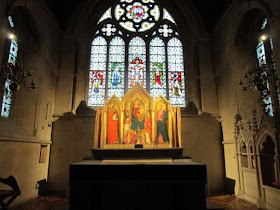I am not the only clergyperson to find Advent wears one's faith a bit thin and certainly it seems to have left me with less brainspace to blog. I have additional thoughts about the recent political discombobulations but they will have to wait until I can think. However I did have time last week on a semi-day off to drop in at the church of Holmbury St Mary where I discovered another unsung Victorian gem.
There was no church here until 1879: in fact, very oddly, the village came to be named after it. Before then it was Felday, its only place of worship being a little brick Dissenting chapel. In 1874 the Gothic Revivalist architect GE Street came here with his wife Maraquita and both were captivated by the remoteness of the landscape so near London. Maraquita died soon after they moved to Felday, and although Street married again his new wife Jessie also died very soon: the church is a sort of memorial to them both. Street was a convinced Anglo-Catholic who served as churchwarden at the Ecclesiological Society's model church of All Saints' Margaret Street, and it's no surprise that Holmbury, while not as lavish as that London jewel, is firmly in the same camp. It has a chancel screen (presumably Bishop Wilberforce was less outraged by such things than Bishop Sumner had been a few years before) and a genuine 14th-century Italian triptych as its reredos which Street always intended should go into the church and which - notwithstanding all the new chairs in the nave - renders the view along the church into something magical.
Holmbury's tradition is watered-down nowadays as it is part of a team with churches that come from a different viewpoint, but as so often happens all the fittings are still there. I'm not sure when the Sacrament began to be reserved, or when the nave was reordered, but at least they resisted the temptation to install an unnecessary nave altar. And those are really the only changes from the church Street would have been familiar with.


No comments:
Post a Comment